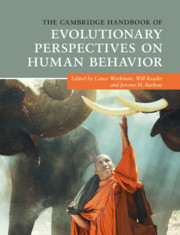Book contents
- The Cambridge Handbook of Evolutionary Perspectives on Human Behavior
- The Cambridge Handbook of Evolutionary Perspectives on Human Behavior
- Copyright page
- Dedication
- Contents
- Figures
- Tables
- Contributors
- Preface
- Acknowledgments
- Part I The Comparative Approach
- Part II Sociocultural Anthropology and Evolution
- Part III Evolution and Neuroscience
- Part IV Group Living
- 10 The Problem of Altruism and Future Directions
- 11 Can Evolutionary Processes Explain the Origins of Morality?
- 12 The Evolution and Function of Third-Party Moral Judgment
- 13 Evolution of the Human Family
- 14 The Parasite-Stress Theory of Cultural Values and Sociality
- 15 The Evolution of Pride and Shame
- 16 Thinking Outside the Head
- Part V Evolution and Cognition
- Part VI Evolution and Development
- Part VII Sexual Selection and Human Sex Differences
- Part VIII Abnormal Behavior and Evolutionary Psychopathology
- Part IX Applying Evolutionary Principles
- Part X Evolution and the Media
- Index
- References
11 - Can Evolutionary Processes Explain the Origins of Morality?
from Part IV - Group Living
Published online by Cambridge University Press: 02 March 2020
- The Cambridge Handbook of Evolutionary Perspectives on Human Behavior
- The Cambridge Handbook of Evolutionary Perspectives on Human Behavior
- Copyright page
- Dedication
- Contents
- Figures
- Tables
- Contributors
- Preface
- Acknowledgments
- Part I The Comparative Approach
- Part II Sociocultural Anthropology and Evolution
- Part III Evolution and Neuroscience
- Part IV Group Living
- 10 The Problem of Altruism and Future Directions
- 11 Can Evolutionary Processes Explain the Origins of Morality?
- 12 The Evolution and Function of Third-Party Moral Judgment
- 13 Evolution of the Human Family
- 14 The Parasite-Stress Theory of Cultural Values and Sociality
- 15 The Evolution of Pride and Shame
- 16 Thinking Outside the Head
- Part V Evolution and Cognition
- Part VI Evolution and Development
- Part VII Sexual Selection and Human Sex Differences
- Part VIII Abnormal Behavior and Evolutionary Psychopathology
- Part IX Applying Evolutionary Principles
- Part X Evolution and the Media
- Index
- References
Summary
We humans have been called “the moral animal” (Wright, 1994). We help others, make sacrifices to uphold our groups, treat others fairly, respect authority, exert self-control, and seek to be pure of heart. We experience moral emotions such as sympathy, gratitude, forgiveness, guilt, and righteous indignation. We judge acts as right, wrong, fair, and unfair, and we judge people as good, bad, virtuous, and vicious. We harbor beliefs about the forms of conduct that we and others should and should not enact, and we justify these beliefs with moral reasons. Children react strongly to violations of moral rules at a very young age. We possess a conscience that bothers us when we violate our moral standards and principles. We express moral outrage at acts we consider unjust, and we are willing to make sacrifices – in some cases, even of our lives – to uphold our moral principles and to fight injustice.
- Type
- Chapter
- Information
- Publisher: Cambridge University PressPrint publication year: 2020



